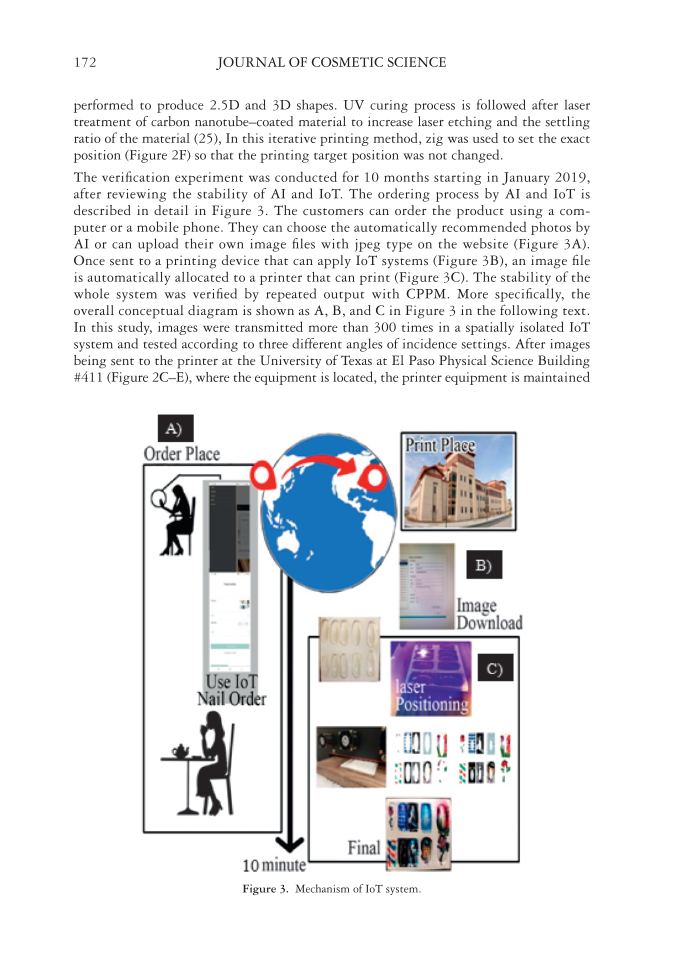CONFORMAL PROJECTION PRINTING METHOD FOR 3D NAIL ART PRINTING 171 solve the problem that these factors can infl uence the print result by using various methods such as measuring the horizontality of output and the bed, including surface tension (23). As the degree of curvature of the conformal surface varied according to the nail tip size, the different injection frequencies were simulated and empirically tested with three zones that, according to the incidence angle (theta), range on the nonhorizontal plane. To minimize the infl uence of such external conditions and to increase precision, a laser treatment process was incorporated that precisely removes the hydrophilic or hydrophobic coating of the output, preventing the spread and diffusion of the ink on the surface. It is reported that the equipment used in this study can be operated at 3W through which the energy consumption is reduced by less than 1/10 times when compared with existing UV lamps (24). The equipment used in the experiment is an A4 UV printer (A4 UV printer Taicang Vevor Machinery Equipment Co., Taicang, China) that outputs only by XYZ movement without rotation axis, and the method of stacking is 2D–2.5D layers on the plane. Figure 2 shows the overall schematic of the mechanical processing of an order for printing. The concept of nail printing and its material chain verifi cation experiment is explained in Figure 2D–F. By combining IoT system and AI, the operator selects the design remotely and the customer can choose by using a system that separates the space between the customer and the operator (Figure 2A). Once the data to be printed are delivered to the Raspberry Pi, which is the central processing unit for processing information (Figure 2B), ink is dispensed through the print head (Figure 2C). The surface was etched with a 3W precision laser (Figure 2D) for surface modifi cation, and repeated printing (Figure 2E) is Figure 2. Basic concept of nail printing and the fl ow of material chain.
JOURNAL OF COSMETIC SCIENCE 172 performed to produce 2.5D and 3D shapes. UV curing process is followed after laser treatment of carbon nanotube–coated material to increase laser etching and the settling ratio of the material (25), In this iterative printing method, zig was used to set the exact position (Figure 2F) so that the printing target position was not changed. The verifi cation exp e riment was conducted for 10 months starting in January 2019, after reviewing the stability of AI and IoT. The ordering process by AI and IoT is described in detail in Figure 3. The customers can order the product using a com- puter or a mobile phone. They can choose the automatically recommended photos by AI or can upload their own image fi les with jpeg type on the website (Figure 3A). Once sent to a printing device that can apply IoT systems (Figure 3B), an image fi le is automatically allocated to a printer that can print (Figure 3C). The stability of the whole system was verifi ed by repeated output with CPPM. More specifi cally, the overall conceptual diagram is shown as A, B, and C in Figure 3 in the following text. In this study, images were transmitted more than 300 times in a spatially isolated IoT system and tested according to three different angles of incidence settings. After images being sent to the printer at the University of Texas at El Paso Physical Science Building #411 (Figure 2C–E), where the equipment is located, the printer equipment is maintained Figure 3. Mechanism of IoT system.
Purchased for the exclusive use of nofirst nolast (unknown) From: SCC Media Library & Resource Center (library.scconline.org)











































































